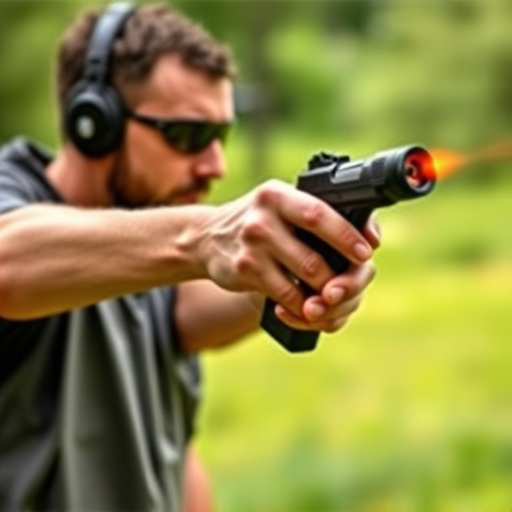Storing pepper spray at home requires a balanced approach: keeping it secure, cool, dry, and out of reach of children. Maintain proper ventilation, avoid extreme temperatures & direct sunlight. Regularly check expiration dates, test functionality, and stay aware of local laws regarding ownership to ensure safe and effective use as a self-defense tool.
“Staying safe in unexpected attacks is paramount, and aerosol spray defense, particularly pepper spray, offers a powerful personal safety tool. This comprehensive guide explores how to effectively utilize this non-lethal force as a last resort. From understanding its composition and effectiveness to mastering application techniques, we equip readers with vital knowledge. Additionally, we delve into legal considerations and safe storage practices for home owners, ensuring responsible ownership. Learn the best practices for storing pepper spray at home, empowering yourself and your loved ones.”
- Understanding Pepper Spray: Its Composition and Effectiveness
- Storing Pepper Spray Safely at Home: Best Practices
- Application Techniques: How to Use Pepper Spray Effectively During an Attack
- Legal Considerations and Safety Precautions for Pepper Spray Ownership
Understanding Pepper Spray: Its Composition and Effectiveness
Pepper spray, a popular and effective self-defense tool, is a powerful chemical compound designed to incapacitate an attacker temporarily. Its primary active ingredient is capsaicin, the same substance that gives chili peppers their heat. This irritant binds to receptors in the eyes, nose, and respiratory system, causing intense discomfort, tears, coughing, and temporary blindness. The spray’s composition also includes a solvent to carry the capsaicin and a binder to ensure it adheres to the target area.
When storing pepper spray at home, proper handling and placement are crucial for safety and effectiveness. Keep it in a cool, dry place away from direct sunlight or extreme temperatures. Ensure it is out of reach of children and secured so it doesn’t fall or get knocked over accidentally. Regularly check the expiration date and test the spray by firing off a test shot to ensure its functionality. Understanding how pepper spray works and maintaining it properly can be a valuable skill in self-defense preparation.
Storing Pepper Spray Safely at Home: Best Practices
When storing pepper spray at home, it’s crucial to prioritize safety and accessibility. Keep it out of reach of children and pets by securing it in a locked cabinet or safe. Ensure the area is cool, dry, and well-ventilated to prevent any damage to the canister. Use a dedicated shelf or hook specifically for self-defense tools to maintain organization and easy retrieval during emergencies.
Best practices include regularly checking expiration dates, as pepper spray can lose its effectiveness over time. Store it away from direct sunlight or extreme temperatures, which can cause the active ingredients to degrade. Also, familiarize yourself with local laws regarding pepper spray ownership and storage, ensuring compliance to avoid legal issues.
Application Techniques: How to Use Pepper Spray Effectively During an Attack
When it comes to using pepper spray effectively during an attack, proper application techniques are crucial. Start by ensuring the can is oriented correctly, with the nozzle aimed at your attacker’s face. A quick thrust and swing of the arm, accompanied by a deep breath, will expel the spray directly into the assailant’s eyes and nasal passage. Maintain a safe distance, typically around three to four feet, allowing the spray to do its work while giving you time to escape. Remember, pepper spray is designed to temporarily incapacitate, so focus on creating enough space to get away and call for help.
Storing pepper spray at home requires careful consideration as well. Keep it in a secure, locked location, out of reach of children or unauthorized individuals. Store the can in its original packaging, ideally in a cool, dry place. Avoid extreme temperatures, direct sunlight, or leaving it in a vehicle, as these conditions can compromise its effectiveness. Regularly check the expiration date and practice handling the spray to ensure familiarity with its deployment mechanism.
Legal Considerations and Safety Precautions for Pepper Spray Ownership
When considering owning pepper spray for self-defense, it’s crucial to be aware of legal considerations and safety precautions. The legality of carrying and using pepper spray varies by jurisdiction, so understanding local laws is essential before purchasing one. Some regions have strict regulations regarding the type, capacity, and accessibility of pepper spray, with certain restrictions on who can possess and carry it. Individuals must ensure they comply with these laws to avoid legal repercussions.
Safety precautions are equally vital when storing pepper spray at home. It should be kept in a secure, locked location, out of reach of children and unauthorized persons. Ideal storage spots include high shelves or lockable cabinets. Additionally, ensuring the spray is stored in its original packaging with clear instructions helps prevent accidental misuse. Regularly checking the expiration date and replacing the spray as needed is also critical for safety and effectiveness.
Pepper spray can be an effective self-defense tool when used properly, but its safety and effectiveness heavily depend on how it’s stored at home. Always keep your pepper spray in a secure, locked location out of reach of children and unauthorized individuals. Ensure the area is cool, dry, and well-ventilated to prevent damage or degradation of the spray. Regularly review application techniques and familiarize yourself with local laws regarding self-defense tools like pepper spray for maximum safety and legal protection.
